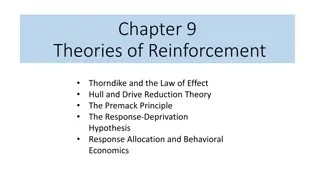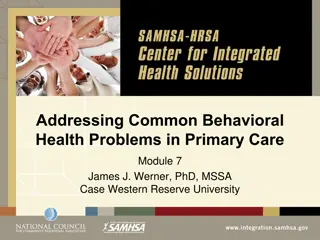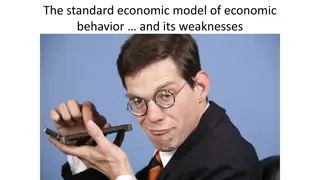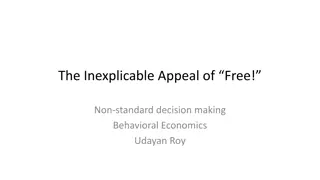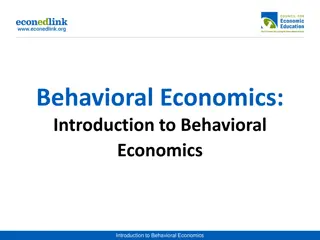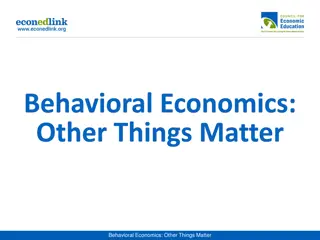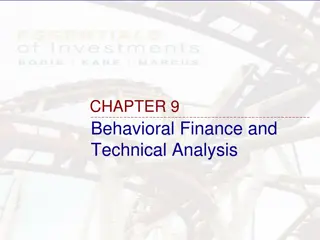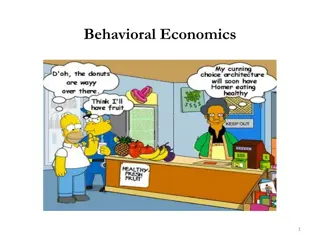Understanding Behavioral Economics and Its Application
Behavioral Economics is a theory that predicts reinforcement effects, winning Richard Thaler a Nobel Prize. It applies economic principles to behavior, with premises on experimental characteristics, elastic demand of reinforcers, and choice behavior complexity. Terms like demand, commodity, price, and budget are defined, along with how changing prices influence behavior. The concept of supply, demand, and equilibrium in behavioral settings is also discussed.
Download Presentation

Please find below an Image/Link to download the presentation.
The content on the website is provided AS IS for your information and personal use only. It may not be sold, licensed, or shared on other websites without obtaining consent from the author. Download presentation by click this link. If you encounter any issues during the download, it is possible that the publisher has removed the file from their server.
E N D
Presentation Transcript
Behavioral Economics! Yep, another theory used to predict reinforcement effects This theory = Nobel Prize for Richard Thaler!
Behavioral Economics Application of economic theory to predict and control behavior Microeconomics Assumes law of supply and demand applies to behavior and reinforcement Is an outgrowth of unidimensional explanations of reinforced behavior Matching law Molar maximizing Disequilibrium models
Four Major Premises 1. A behavioral experiment is an economic system. As such, the characteristics of the experiment can strongly determine the results 2. Reinforcers can be distinguished by a functional property called elasticity of demand that is independent of relative value 3. Reinforcers may interact as complements as well as substitutes 4. Because reinforcers differ in elasticity and because reinforcers can be complementary, no simple unidimensional choice rule can account for all choice behavior
Define the Terms Demand: How much of a product (commodity) will be purchased by the organism at a given price Product or Commodity: the Reinforcer How Purchase Commodities?: A contingent behavioral response e.g., bar press, turn in homework, a dog must sit Price: Schedule of reinforcement or more commonly Response/reinforcer (cost): e.g. for a FR5: 5/1 Budget: Total number of responses allowed per session
Changing Price alters behavior: Changes in price = changes in the reinforcement schedule E.g. Fixed Ratio schedules: FR1: one response = 1 commodity or reward FR 5: five responses = 1 commodity or reward Changes the COST or PRICE of the Commodity This can both effect and be affected by Demand elasticity, Substitutability and Open vs. closed economies
Supply, Demand, and Equilibrium Supply curve: D = demand S = Sr schedule or environmental constraint for obtaining the commodity Q = Quantity per unit time provided at given price P = Price of the commodity (reinforcer) As price per unit increases, rate of production (responding) increases
Supply, Demand, and Equilibrium Demand curve Amount that the subject will consume at a given price or the price that will be paid for a given rate of consumption As price increases, consumption generally decreases Measured in terms of consumption
Supply, Demand, and Equilibrium Equilibrium: Stable outcome of these two curves Where they intersect
Budget Lines Changes the amount the organism is allowed to spend Compares how much the subject will buy of commodity X versus commodity Y Alters the number of responses allowed across the session Yields different constraint or budget lines In a sense: Shows PREFERENCE for buying X vs. Y Differs from price: Is not just the price of an individual item But the total amount the animal has to spend . These factors (price and budget) interact with the animals preference or demand
Demand interacting with Price: Elasticity Curves. INELASTIC: Quantity demand decays gradually with increases in price. Note that R-rate will be an increasing function of price ELASTIC: Demand decays steeply with increases in price. Note that R-rate will be a decreasing function of price A UNIT demand curve Generates a precisely flat level of expenditure or R-rate with increasing price Each increase in price is precisely balanced by a decrease in consumption
Curvature of Demand ELASTICITY COEFFICIENT = absolute value of that slope <1 for inelastic demand = 1 for unit demand >1 for elastic demand The closer the curve comes to the axes, the more demand there is for the commodity Deep curvature = more demand Less curvature = less demand
Hurshs Exponential Model of Demand Equation: IV = C or cost Log of consumption = log Q Function of cost and responding s (buying the commodity) maximum at 0 cost (log Q0) Specifies highest demand = constant: determines the rate of decline in relative consumption (log Q) with increases in cost (C) Value of k = scaling constant that reflects range of data (range of costs used in experiment)
Hurshs Exponential Model of Demand The rate of change in demand elasticity, when K is constant, is determined by the rate of The value of = sensitivity of consumption to changes in cost Is inversely proportional to the ESSENTIAL VALUE (EV) of the reinforcer EV = theoretically constant reinforcing value of the commodity, regardless of the unit size
Several important predictions The form of the demand curve depends on the dimensions of the goods purchased (reinforcers earned) Differences in size of the reinforcer Differences in the amount of the reinforcer Even differences in the quality of the reinforcer For example: when commodities differ in size, it takes varying amounts of each to reach satiation E.g., if twice as big, takes half the time/amount This is reflected in Q0 This means that there are differences in true cost required to defend baseline demands differ Takes more small packages to reach satiation than large packages
Several important assumptions Standardized price: Q0x C Separates cost factors from the essential value Hursh: like providing unit price rather than just package price True price can be raised by: Charging more for same package Making package smaller, selling at same price And vice versa for lowering price
Several important predictions Essential value = EV EV = Is linearly related to price at which demand elasticity = -1 and overall responding is maximal Pmax = Defined for demand in normalized units of consumption All levels of consumption are expressed as a percent of maximal consumption (Q0= 100%) Price is normalized units of cost per 1% units of consumption (C x Q0/100) Varies with value of K Exact estimate obtained by replacing the constant of 100 in the Exponential demand equation and adjusting for the value of K
Can now compare different reinforcers and prices Winger, et al. (2002) Three drugs self administered by monkeys Differed in time of onset to peak drug effect Ketamine 1 min Phencyclidine 10 min Dizocilpine 32 min Used several doses and changed price across each dose Wanted to determine of elasticity of demand would vary for the three drugs
Results Note could isolate dose differences using Pmax, so could equate across doses Makes sensitivity to price a constant across doses Found distinct differences in demand curves More importantly, look at EV for the three drugs
Results EV not directly related to potency Lowest potency = ketamine: was 10x more reinforcing by unit dose than dizocilpine! Sensitivity to price was 25% of that for dizocilpine and had a higher EV This study and others by Roma suggest that EV may be related to potential of abuse Higher EV and lower sensitivity increases potential for abuse! Also note that this relates to time to peak effect: sooner the peak effect, the more reinforcing the drug! EV is an inverse to delay of reinforcement!!!!!!
What else affects Elasticity of Demand?
Reinforcers interact as substitutes or complements Substitutes: Reduction in demand of one commodity as the supply for a second commodity increased Complete substitutability suggests the two reinforcers are equivalent One commodity is as good as another Pepsi vs. Coke ? Store brand vs. generic brand?
Reinforcers interact as substitutes or complements Complements: Increase in demand of one commodity as supply for a second commodity increased Complete complementarity suggests the two reinforcers are nonsubstitutable or complements Peanut Butter and Jelly Water vs. food
Own-price vs. cross-price elasticity Own price elasticity of demand Slope of demand curve for commodity when plotted using typical equation Reflects proportional changes in consumption of commodity with proportional changes in its own price Cross-price elasticity of demand: Slope of the function relating the consumption of a second commodity at a fixed price to changes in price of an alternative commodity If function has positive slope: second commodity= substitute If function has a negative slope: second commodity = compliment Qalone= level of demand for constant price commodity B at infinite price (C) for commodity A I = interaction constant = sensitivity of commodity B consumption to the price of commodity A CAis the cost of commodity A
Substitutes! Human subjects chose between methadone (increasing FR schedule from FR30) and hydromorphone (FR 30) Even at lowest price of methadone, some hydromorphone consumed As price increased, consumption of hydromorphone increased, methadone decreased This true even compared to price increases when methadone offered alone! When hydromorphone was available: Sensitivity to methadone doubled (price comparing!) Level of demand (Qo) reduced 33% How could this be used in drug treatment?
Compliments Ethanol vs. cigarette puffs: Did alone and own-price comparison Ethanol offered at constant price Cigarette puffs price varied
Open versus Closed Economies Open Economy: Extra sources of reward are available outside the experimental (or real) session Can get more commodities outside your budget Rats are supplementally fed after the daily session You can call your parents when run out of money at end of month
Open versus Closed Economies Closed Economy: Extra sources of reward are available outside the experimental (or real) session Can NOT get more commodities outside your budget Rats must work for all of their food during an experimental session Your monthly budget is as it is: no extra sources of income
Differences in consumption for Open versus Closed Economies: Open economies and closed economies have different effects on consumption Response rates in closed economies INCREASE as price increases; Must respond more to maintain consumption Response rates in open economies DECREASE as price increases; Do not maintain consumption
Responding on Open versus Closed Economies
Why is this distinction important? Drug addict behavior in open vs. closed economies Open Economy: Many outside sources of commodities Parents will enable, pay rent Can beg, steal, rob for money No reason to allocate money for food, as can always get more As a result, spend more of $$ on drugs
Why is this distinction important? Drug addict behavior in open vs. closed economies Closed Economy: No or limited outside sources of commodities No one to enable, pay rent No opportunity to beg, steal, rob for money Must allocate money for food, must eat As a result, spend little to no $$ on drugs
Hursh, 1980 Gave baboons choice between food and heroin infusion: Early data sessions shown both commodities relatively inelastic When no restriction on income: Open economy Supplemental feeding at end of session Responding roughly equal for both Relatively inelastic Would choose to take heroin infusions When restriction income: # of R's/day: Closed economy: When price = low: baboons still choose roughly equal When price = high: Demand for heroin dropped Demand for food increased
Animals make bad choices based on good decision making! Anchoring: we value things more highly when we have them in hand (own them). Loss aversion: Organisms experience the negative feeling of loss more strongly than they feel the positive sense of a gain of the same size We avoid losing, even if it will gain us something more
Animals make bad choices based on good decision making! Planning and doing Organisms are good at planning Not was good at executing the response Issues of self control Availability heuristic: Organisms choose based on how readily the reinforcer is to them. Temporal discounting! Status quo bias: Organisms tend to keep making the same choice Issue of Behavioral Momentum
Summary EV (essential value) may be hugely affected by availability of alternative reinforcers! When substitutes are available: EV of a reinforcer declines compared to when no other reinforcer is available Low priced concurrently available substitutes lower EV the most Compliments INCREASE Essential value These types of interactions are not included in linear models of reinforcement efficacy like the matching law!
Summary Evidence suggests that behavior of animals in conditioning experiments conforms to economic predictions Implies that operant conditioning constitutes a kind of economic decision making We think we are logical, but we respond based on our reinforcement history, not necessarily logic. Like other modern theories in operant conditioning, allows prediction of reinforcement effect









